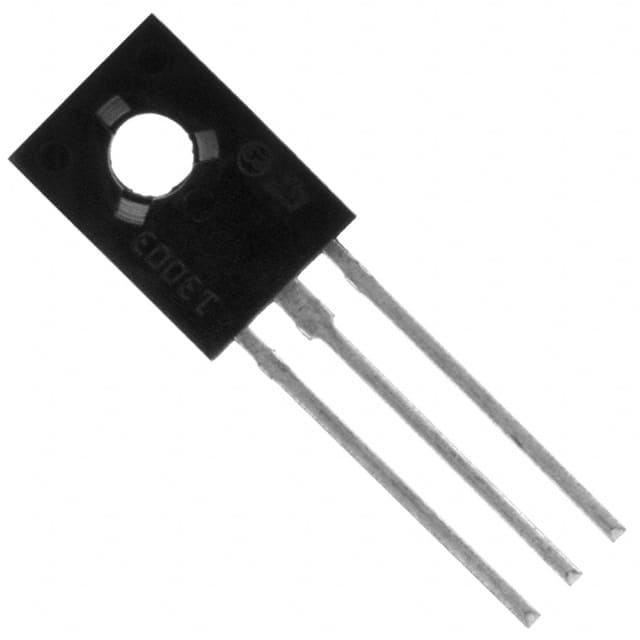Xem thông số kỹ thuật để biết chi tiết sản phẩm.

2N5657 Transistor
Product Overview
Category:
The 2N5657 is a bipolar junction NPN transistor.
Use:
It is commonly used as an amplifier or switch in electronic circuits.
Characteristics:
- Low power dissipation
- High current gain
- Medium voltage capability
Package:
The 2N5657 is typically available in a TO-39 metal can package.
Essence:
The essence of the 2N5657 lies in its ability to amplify and control electrical signals in various electronic applications.
Packaging/Quantity:
The 2N5657 is usually sold in reels or tubes containing multiple units, with quantities varying based on manufacturer and distributor specifications.
Specifications
- Collector-Base Voltage (VCBO): 80V
- Collector-Emitter Voltage (VCEO): 40V
- Emitter-Base Voltage (VEBO): 5V
- Collector Current (IC): 600mA
- Power Dissipation (PD): 625mW
- Transition Frequency (fT): 150MHz
- Operating Temperature: -65°C to 200°C
Detailed Pin Configuration
The 2N5657 transistor has three pins: 1. Collector (C) 2. Base (B) 3. Emitter (E)
Functional Features
- High current gain allows for small base current to control larger collector current.
- Suitable for low-power amplification and switching applications.
Advantages
- Low power dissipation makes it suitable for battery-operated devices.
- High current gain provides efficient signal amplification.
Disadvantages
- Limited voltage and current ratings compared to other transistors.
- Relatively lower transition frequency may limit high-frequency applications.
Working Principles
The 2N5657 operates based on the principles of bipolar junction transistors, where the flow of current between the collector and emitter is controlled by the base current.
Detailed Application Field Plans
Audio Amplification
The 2N5657 can be used in audio amplifiers to boost weak audio signals.
Switching Circuits
Due to its medium voltage capability, the 2N5657 is suitable for use in low-power switching circuits.
Oscillator Circuits
In low-frequency oscillator circuits, the 2N5657 can provide stable signal generation.
Detailed and Complete Alternative Models
- 2N3904
- BC547
- 2N2222
In conclusion, the 2N5657 transistor offers a balance of characteristics suitable for various low-power electronic applications, such as amplification and switching. Its availability in a standard TO-39 package and compatibility with alternative models make it a versatile component in electronic circuit design.
[Word count: 398]
Liệt kê 10 câu hỏi và câu trả lời thường gặp liên quan đến ứng dụng 2N5657 trong giải pháp kỹ thuật
What is the 2N5657 transistor used for?
- The 2N5657 is a high-frequency, high-gain NPN transistor commonly used in RF and microwave applications.
What are the key specifications of the 2N5657 transistor?
- The 2N5657 has a maximum collector current of 50mA, a maximum power dissipation of 300mW, and a transition frequency of 800MHz.
How can the 2N5657 be used in amplifier circuits?
- The 2N5657 can be used as a low-noise amplifier in RF and microwave circuits due to its high gain and frequency capabilities.
What are some common biasing configurations for the 2N5657?
- Common biasing configurations for the 2N5657 include fixed bias, emitter bias, and voltage divider bias.
Can the 2N5657 be used in oscillator circuits?
- Yes, the 2N5657 can be used in oscillator circuits due to its high-frequency capabilities and stability.
What are the typical applications of the 2N5657 in communication systems?
- The 2N5657 is commonly used in communication systems for amplification, oscillation, and signal processing in RF and microwave frequencies.
What are the thermal considerations when using the 2N5657 in a circuit?
- It's important to consider proper heat sinking and thermal management to ensure the 2N5657 operates within its specified temperature range for optimal performance and reliability.
Are there any common failure modes associated with the 2N5657?
- Common failure modes include thermal runaway due to inadequate heat dissipation and overvoltage breakdown if operating beyond its maximum ratings.
What are some alternative transistors that can be used as substitutes for the 2N5657?
- Alternatives include the 2N5179, 2N918, and 2N4427, which have similar characteristics and can be used in similar applications.
Where can I find detailed application notes and reference designs for using the 2N5657 in technical solutions?
- Detailed application notes and reference designs can often be found in the datasheet provided by the manufacturer, as well as in technical literature and online resources related to RF and microwave circuit design.

